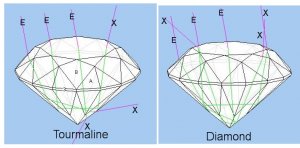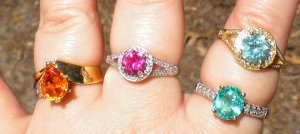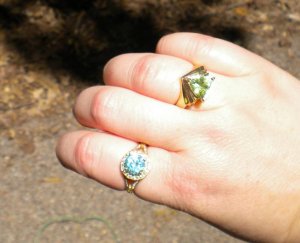cellentani
Ideal_Rock
- Joined
- Dec 28, 2008
- Messages
- 3,820
Date: 5/29/2009 10:34:39 PM
Author: cellentani
Date: 5/29/2009 10:30:18 PM
Author: PrecisionGem
Most stones go almost black in direct bright sunlight, especially a round design. Those standard round brilliant cuts do suffer from extinction. Daylight in the shade, or away from direct sunlight is the preferred light when evaluating a stone.
Nice to see you, Gene. In your expert opinion, which cut performs the best in varied lighting, with the least amount of extinction?
Ahhh, this is why I love PS - you get such great info! Very interesting about the checker crown - I''ve never liked them much because they seem to be on all the cheap stones in department stores. In fact, I have a couple stones with checker crowns that I will have to dig out again.Date: 5/29/2009 11:14:23 PM
Author: PrecisionGem
Date: 5/29/2009 10:34:39 PM
Author: cellentani
Date: 5/29/2009 10:30:18 PM
Author: PrecisionGem
Most stones go almost black in direct bright sunlight, especially a round design. Those standard round brilliant cuts do suffer from extinction. Daylight in the shade, or away from direct sunlight is the preferred light when evaluating a stone.
Nice to see you, Gene. In your expert opinion, which cut performs the best in varied lighting, with the least amount of extinction?
The best cut is really a function of the type of stone, as each stone has a different refractive index, and also the size of the stone. Smaller stones typically should have fewer facets. I find that stones with a smaller table perform better. Checkers if done right usually have less extinction, because they will allow you to cut the pavilion closer to the critical angle with out the stone windowing. I have never been a big fan of SRB (standard round brilliant) cuts. This is always the first cut a cutter does, since it''s the easiest, and well documented and published all over the place. But in most materials, the stone suffers from extinction as shown in many of the photos on this thread. Often with a design, ''less is more'' is very true. Fewer facets will perform well with darker stones, as will less symmetry. I cut a lot of stones that are based on a symmetry of 5, which is of course an odd number. I find this works better than the standard round which is based on a symmetry of 8.
I know some people have claimed that you shouldn''t buy a checker crown, since the cutter used it to hide inclusions. This just isn''t true. A checker crown can really help to eliminate extinction and brighten up a stone, and it really doesn''t hide inclusion much better than anything else.


I''m flattered! Yes they remain my favorites, so much so that I recently got a pair of matching small ones to be set into earringsDate: 5/30/2009 10:20:18 AM
Author: cellentani
Hey Babyblue!! I''ve got your garnet pics on my computer, and you''ve no idea how many faceters I''ve sent them to - I hope you don''t mind.I love the color of Gene''s umbalites - they seem so sparkly too. Are you still really happy with those stones? Are they as bright and vivid IRL as they seem in your pics? I know you sent quite a few PSers scurrying to find similar stones after you posted yours.


Thanks for your feedback, Babyblue! Is your pendant stone a lot larger than your ring (the ring umbalite is 8.5mm, right)? I wonder if that accounts for at least some of the color difference? I really enjoyed (and found helpful) the pics you posted of your pinkish-red stones in different lights (can''t remember the thread). I''m jealous that you''ve been so successful at finding delicious raspberry-pink sparklies, but I hear you about those hotter pinks. It''s hard to beat a vivid pink sapphire! Do you have pics of your matching pair? I definitely think we need to see them!Date: 5/30/2009 11:59:16 AM
Author: Babyblue033
I''m flattered! Yes they remain my favorites, so much so that I recently got a pair of matching small ones to be set into earringsDate: 5/30/2009 10:20:18 AM
Author: cellentani
Hey Babyblue!! I''ve got your garnet pics on my computer, and you''ve no idea how many faceters I''ve sent them to - I hope you don''t mind.I love the color of Gene''s umbalites - they seem so sparkly too. Are you still really happy with those stones? Are they as bright and vivid IRL as they seem in your pics? I know you sent quite a few PSers scurrying to find similar stones after you posted yours. I like the color of the larger stone in my pendant over my ring, ring shows much purple/lavender in some lighting, but overall they have delicious raspberry color and hold up colors pretty well in most lighting conditions. And I think this particular faceting really compliments the colors, as they seem to really catch the light as the stone moves.
I like the color of the larger stone in my pendant over my ring, ring shows much purple/lavender in some lighting, but overall they have delicious raspberry color and hold up colors pretty well in most lighting conditions. And I think this particular faceting really compliments the colors, as they seem to really catch the light as the stone moves.
My next goal though is to try for more ''hotter'' pinks though, a pink spinel or even pink sapphire if I can afford it. But I just can''t resist a good Umbalite, I have such a soft spot for them
Most of mine love diffused lighting. Only a very few look good in direct and diffused lighting. Perhaps part of the reason is due to precision cutting? I thought I read here on PS (by Gene or Jeff maybe?) that he cuts the gems to maximize colour for diffused lighting due to some critical angles or something like that.Date: 5/29/2009 10:39:35 PM
Author: tourmaline_lover
That''s so funny because I actually love my stones (rounds included) in direct sunlight, even though Michael E and Gene say it''s not the best light to view gems. The color explodes when the sun hits them. I took a picture of them full face on in the sun, and it was cool!!Date: 5/29/2009 10:30:18 PM
Author: PrecisionGem
Most stones go almost black in direct bright sunlight, especially a round design. Those standard round brilliant cuts do suffer from extinction. Daylight in the shade, or away from direct sunlight is the preferred light when evaluating a stone.
I must have weird gems.

Date: 5/30/2009 1:46:22 PM
Author: Chrono
Only a very few look good in direct and diffused lighting. Perhaps part of the reason is due to precision cutting?

Michael- thanks for posting this, very educational and great learning toolDate: 5/30/2009 3:09:42 PM
Author: Michael_E
Date: 5/30/2009 1:46:22 PM
Author: Chrono
Only a very few look good in direct and diffused lighting. Perhaps part of the reason is due to precision cutting?
I wish ! No, the reason is mostly due to the inherent optical properties of the material, basically the Refractive Index, (RI). When light hits a low RI gem at an angle it mostly goes right on through the gem. Since it''s not coming back to your eyes, it looks dark. The lower the RI of a gem, the smaller the angle that light entering it will bounce back to you. Here''s a pair of images showing light entering a stone at 10° from vertical in a diamond and a tourmaline,(entering rays labeled ''E''; exiting rays labeled ''X''). 10° isn''t much, but the tourmaline just turns into a ''leaky bucket'' of light. When you combine this with the blocking effect of your head and upper body of about 5°, it just doesn''t leave much room for light to enter and come back to you, (high RI gems look brighter since this angle that light can enter and still get back to you is greater). This is why diffuse light is so important, in that it entirely fills the gap between your ''head shadow'' and the angle at which light just goes right through the stone.
I have a tourmaline with a huge window, the worst cutting imaginable, and it''s a low RI gemstone, and when the sun hits it, OMG!! It''s like it lights up from it''s own electric source. What explains that?Date: 5/30/2009 3:09:42 PM
Author: Michael_E
Date: 5/30/2009 1:46:22 PM
Author: Chrono
Only a very few look good in direct and diffused lighting. Perhaps part of the reason is due to precision cutting?
I wish ! No, the reason is mostly due to the inherent optical properties of the material, basically the Refractive Index, (RI). When light hits a low RI gem at an angle it mostly goes right on through the gem. Since it''s not coming back to your eyes, it looks dark. The lower the RI of a gem, the smaller the angle that light entering it will bounce back to you. Here''s a pair of images showing light entering a stone at 10° from vertical in a diamond and a tourmaline,(entering rays labeled ''E''; exiting rays labeled ''X''). 10° isn''t much, but the tourmaline just turns into a ''leaky bucket'' of light. When you combine this with the blocking effect of your head and upper body of about 5°, it just doesn''t leave much room for light to enter and come back to you, (high RI gems look brighter since this angle that light can enter and still get back to you is greater). This is why diffuse light is so important, in that it entirely fills the gap between your ''head shadow'' and the angle at which light just goes right through the stone.
My guess is that the bad cutting (not getting the critical angles) actually helps the stone "perform" in direct lighting. This is how I understand and inteprete Micheal's explaination.Date: 5/30/2009 8:33:13 PM
Author: tourmaline_lover
I have a tourmaline with a huge window, the worst cutting imaginable, and it's a low RI gemstone, and when the sun hits it, OMG!! It's like it lights up from it's own electric source. What explains that?
How does that same tourmaline perform in other lighting conditions?Date: 5/30/2009 11:21:38 PM
Author: Chrono
My guess is that the bad cutting (not getting the critical angles) actually helps the stone ''perform'' in direct lighting. This is how I understand and inteprete Micheal''s explaination.Date: 5/30/2009 8:33:13 PM
Author: tourmaline_lover
I have a tourmaline with a huge window, the worst cutting imaginable, and it''s a low RI gemstone, and when the sun hits it, OMG!! It''s like it lights up from it''s own electric source. What explains that?
In other lighting conditions, it's still neon and quite beautiful. I really can't think of a lighting situation where it looks ugly, incandescents, fluorescents, on cloudy days, but when the sun hits it, watch out!! It's kind of like if you have your headlights on your car, and then you turn your brights on. You need your sunglasses because the color gets so intense. It's really difficult to explain. I spend a lot of time staring at it, not good when you're driving. People comment on it all the time, especially men. Weird.Date: 5/31/2009 12:22:03 AM
Author: cellentani
How does that same tourmaline perform in other lighting conditions?Date: 5/30/2009 11:21:38 PM
Author: Chrono
My guess is that the bad cutting (not getting the critical angles) actually helps the stone 'perform' in direct lighting. This is how I understand and inteprete Micheal's explaination.Date: 5/30/2009 8:33:13 PM
Author: tourmaline_lover
I have a tourmaline with a huge window, the worst cutting imaginable, and it's a low RI gemstone, and when the sun hits it, OMG!! It's like it lights up from it's own electric source. What explains that?
Maybe your eyes, definitely not mine!! LOL! Seriously, my cuprians, rubellite and spess look great with full direct sun on them. They look good with indirect as well. I do know what you're talking about with some gems though that show a glare when in the sun. Yes, that is true, but some gems do deepen a bit in color when the sun is hitting them. It is a strange phenonmenon.Date: 5/31/2009 10:25:35 AM
Author: PrecisionGem
I took 100 stones out yesterday into the sun. With may back to the sun, and the trays of stones shaded they looked fantastic. When looking at the whole tray in direct sun, they looked bright, but I think what is going on is that the sun is so bright, that it's too much light, and they over power your eye. From a distance this effect wasn't so noticeable. It seems more of a glare than anything else. Maybe being in the gem jars doesn't help, but I wasn't about to lay 100 stones out on the deck to blow around.
Indirect sunlight is the best light for viewing a stone, and considered the reference.

TL, I have the same hunch as you that precision cut stones are best viewed under diffused or indirect lighting. They don't perform as well under direct sunlight.Date: 5/31/2009 2:16:03 PM
Author: tourmaline_lover
I think the lighter color precision faceted gems tend to show much more glare, as indicated by this picture. The three stones at the bottom are medium in tone and more on the vivid side of saturation, and they go even deeper in color when the sun is hitting them. The above right one is not as vivid as the others, but has an amazing precision faceting job on it. When I look at it in direct sun, it hurts my eyes because most of what you see is light return from the facets. Precision faceting is meant to return a good degree of light back to your eye.
I made sure there was no head shadow in the picture and good 'ole Sol was 93 million miles above these stones on a no cloud day.
Although the camera is pixilating it quite a bit (hard to focus in bright light), you can see the clear difference between the gem in the upper right hand corner and the others.
I love precision faceted stones, but I do think they're not the best for viewing in direct sunlight.
The other stones seem to soak of the light and get more vivid in color. I will next show a fuzzy picture to demonstrate the truer color that I see (fuzzy shots tend to show color better).
Date: 5/31/2009 4:14:34 PM
Author: Chrono
TL, I have the same hunch as you that precision cut stones are best viewed under diffused or indirect lighting. They don''t perform as well under direct sunlight.


